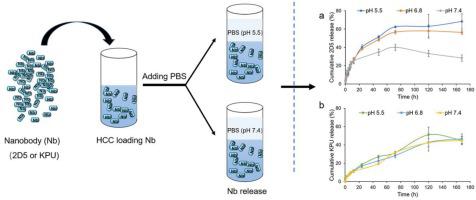Colloids and Surfaces B: Biointerfaces ( IF 5.4 ) Pub Date : 2020-07-13 , DOI: 10.1016/j.colsurfb.2020.111261 Xiying Fan 1 , Yunlong Liang 1 , Yuting Cui 2 , Fei Li 3 , Yue Sun 2 , Junqing Yang 2 , Haipeng Song 3 , Zixian Bao 4 , Rui Nian 2

|
Recently, injectable hydrogels have shown great potential in cell therapy and drug delivery. They can easily fill in any irregular-shaped defects and remain in desired positions after implantation using minimally invasive strategies. Here, we developed hydrogels prepared from tilapia skin collagen and chitosan (HCC). The residual mass rate of HCC was affected by the pH at the time of preparation, which was 29.1 % at pH 7 in 36 h. By comparison, the residual mass ratios of HCC at pH values of 6 and 5 were only approximately 8.4 % and 0, respectively. In addition, the stability of HCC was also affected by the concentration of these two components. HCC10 catalyzed by 10 mg mL−1 tilapia skin collagen and 10 mg mL−1 chitosan was more stable than HCC5 catalyzed by 5 mg mL−1 tilapia skin collagen and 10 mg mL−1 chitosan; therefore, we studied that ability of HCC10 to deliver two model nanobodies: 2D5 and KPU. As the concentration of nanobodies increased, the cumulative release rate of 2D5 decreased, and the release rate of KPU increased. Meanwhile, the cumulative release rate of 2D5 was the highest (68.3 %) at pH 5.5, followed by pH 6.8 (56.4 %) and 7.4 (28.4 %). However, the cumulative release rates of KPU were similar at pH 5.5 (45.1 %), 6.8 (46.5 %), and 7.4 (44.9 %). HCC is biodegradable, and can facilitate the release nanobodies; thus, HCC could be developed into an intelligent responsive tumor treatment matrix for use in cancer therapy.
中文翻译:

用于纳米抗体递送的罗非鱼胶原蛋白和壳聚糖复合水凝胶的开发。
最近,可注射水凝胶在细胞治疗和药物递送方面显示出巨大的潜力。它们可以使用微创策略轻松填充任何形状不规则的缺陷并在植入后保持在所需位置。在这里,我们开发了由罗非鱼皮肤胶原蛋白和壳聚糖 (HCC) 制备的水凝胶。HCC 的残留质量率受制备时的 pH 值影响,在 pH 7 时 36 小时为 29.1%。相比之下,在 pH 值为 6 和 5 时,HCC 的残留质量比分别仅为大约 8.4% 和 0。此外,这两种成分的浓度也影响HCC的稳定性。10 mg mL -1罗非鱼皮肤胶原蛋白和10 mg mL -1壳聚糖催化的HCC10比5 mg mL -1催化的HCC5更稳定罗非鱼皮肤胶原蛋白和 10 mg mL -1壳聚糖;因此,我们研究了 HCC10 提供两种模型纳米抗体的能力:2D5 和 KPU。随着纳米抗体浓度的增加,2D5的累积释放率降低,KPU的释放率增加。同时,2D5 的累积释放率在 pH 5.5 时最高(68.3 %),其次是 pH 6.8(56.4 %)和 7.4(28.4 %)。然而,KPU 的累积释放率在 pH 5.5 (45.1 %)、6.8 (46.5 %) 和 7.4 (44.9 %) 时相似。HCC 是可生物降解的,可以促进纳米抗体的释放;因此,HCC 可以发展成为一种智能响应的肿瘤治疗矩阵,用于癌症治疗。











































 京公网安备 11010802027423号
京公网安备 11010802027423号